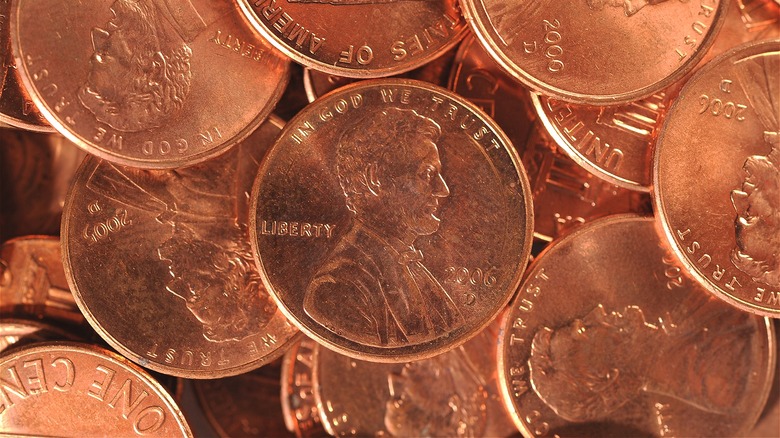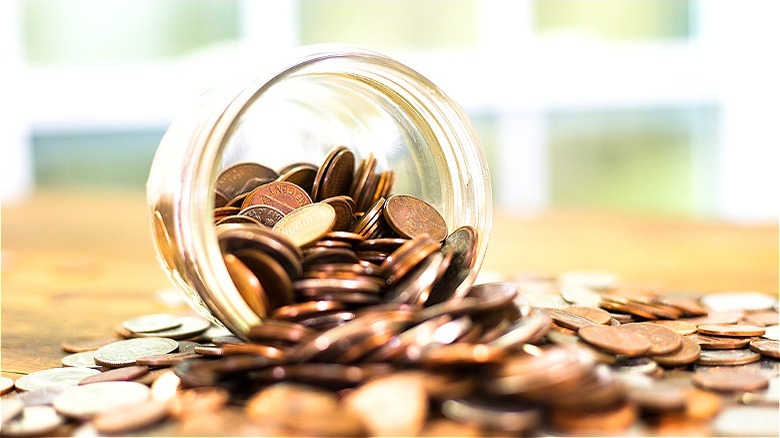The Penny Costs More To Make Than It's Worth
Money Digest has already taken a look at how much the $1 bill costs to make. Spoiler alert: It's 7.5 cents. Even the math-impaired among us can quickly tabulate that this represents 7.5% of the value of the note just to produce it. By contrast, the $100 bill is much thriftier with a production cost of 17 cents against its considerable purchasing power. However, the worst value proposition by far among U.S. currency is the lowly penny. When the Lincoln penny first debuted in 1909, it was the first coin to feature a historical person in commemoration of President Lincoln's 100th birthday. Prior to that, some coins displayed Native Americans, but their identities were anonymous.
In 2022, the United States Mint disclosed that it cost 2.72 cents to produce each penny, a jump of nearly 30% over the prior year's cost. The Mint cites the higher cost of metals like copper and zinc for the price increase. That difference between the face value of a coin or paper bill and the cost of producing it is known in the industry as "seigniorage." In the case of coins, such as the dime and the quarter, the seigniorage netted the Mint $141.6 million and $337.1 million, respectively. However, the Mint "lost" $171 million by making pennies in 2022, when considering the difference between producing the one-cent coins and their face value.
It's illegal to profit from the arbitrage
In theory, it's possible to melt down U.S. pennies to capture their metal content at a profit. That's especially true for older pennies, which have a higher copper content — with the exception of some steel pennies made during World War II due to rationing of other materials. However, by 1982, the cost of copper was already growing unaffordable, so the penny formula was changed to copper plating over a mostly zinc base.
Regardless of potential profitability, a 2006 law from the U.S. Mint makes it illegal to melt down pennies (or nickels), as well as prohibits the export of those coins in large quantities. At the time of the announcement, Edmund Moy, who served as the director of the United States Mint from 2006 to 2011, told ABC News that the nation needs the coins for engaging in commerce. Said Moy, "[I]f just 1 percent of all the nickels and pennies that are in circulation were melted down, taxpayers would have to foot a $43 million bill."
Besides melting pennies and nickels, Americans can also run afoul of the law by taking $5 or more worth of these coins out of the country on their person or alternatively, mailing or shipping out more than $100 worth. Doing so can put you on the hook for a $10,000 fine and/or land you in prison for up to five years.
Reports of the penny's death are greatly exaggerated
Conversations about the penny's demise have been around for decades. As far back as 1989, a bill was put forward to Congress that suggested a rounding system that would allow products/services to continue to be priced in cents, but cash payments would be rounded up or down to the nearest five- cent amount. Interestingly, consumers using checks, credit cards, or debit cards would continue to pay the exact price.
Several years later, in 1996, the United States General Accounting Office took a public poll about eliminating the penny. According to reports, the results were split fairly evenly between those who preferred rounding to the nearest nickel versus those who found the penny useful. At that time, it still cost less than one cent to make each penny, but the government still lost $8 million to $9 million on the coin in 1994 because of the logistical expense of distributing pennies to commercial banks.
Fast forward almost 30 years and the U.S. Mint is still in search of ways to save money when it comes to coin production. Although the metallurgical makeup of coins has already been tweaked for economy over the years, a bill was introduced to the Senate in 2023 requesting additional latitude to substitute less expensive materials. Even so, it seems like getting the production cost of the humble penny under one cent is an impossibility. Such is the cost of tradition, we suppose.

